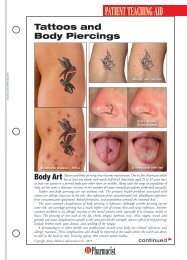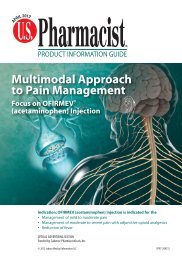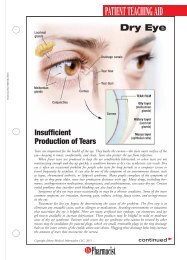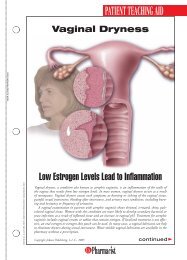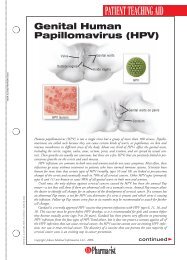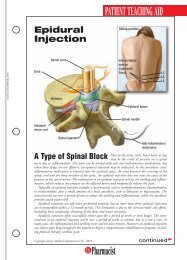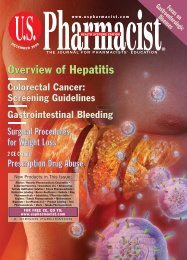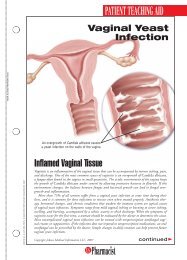View PDF Edition - U.S. Pharmacist
View PDF Edition - U.S. Pharmacist
View PDF Edition - U.S. Pharmacist
You also want an ePaper? Increase the reach of your titles
YUMPU automatically turns print PDFs into web optimized ePapers that Google loves.
other opioids, or to subtract the frequencies reported by placebo-treated patients in controlled trials.Adverse reactions reported in 153 cancer patients at a frequency of 1% or greater are presented in Table 1;similar reactions were seen in the 357 postoperative patients.In the pediatric population, the safety of fentanyl transdermal system has been evaluated in 291 patients withchronic pain 2 to 18 years of age. The duration of fentanyl transdermal system use varied; 20% of pediatric patientswere treated for 15 days; 46% for 16 to 30 days; 16% for 31 to 60 days; and 17% for at least 61 days. Twenty-fivepatients were treated with fentanyl transdermal system for at least 4 months and 9 patients for more than 9 months.There was no apparent pediatric-specific risk associated with fentanyl transdermal system use in children as youngas 2 years old when used as directed. The most common adverse events were fever (35%), vomiting (33%), andnausea (24%).Adverse events reported in pediatric patients at a rate of 1% are presented in Table 1.TABLE 1: ADVERSE EVENTS (at rate of ≥ 1%)Adults (N = 380) and Pediatric (N = 291) Clinical Trial ExperienceBody System Adults PediatricsBody as a Whole Abdominal pain*, headache*, fatigue*, Pain*, headache*, fever,back pain, fever, influenza-like symptoms*, syncope, abdominal pain,accidental injury, rigorsallergic reaction, flushingCardiovascular Arrhythmia, chest pain Hypertension, tachycardiaDigestive Nausea**, vomiting**, constipation**, Nausea**, vomiting**,dry mouth**, anorexia*, diarrhea*,constipation*, dry mouth,dyspepsia*, flatulencediarrheaNervous Somnolence**, insomnia, confusion**, Somnolence*, nervousness*,asthenia**, dizziness*, nervousness*,insomnia*, asthenia*,hallucinations*, anxiety*, depression*, euphoria*, hallucinations, anxiety,tremor, abnormal coordination, speech disorder, depression, convulsions,abnormal thinking, abnormal gait,dizziness, tremor, speechabnormal dreams, agitation, paresthesia, disorder, agitation, stupor,amnesia, syncope, paranoid reactionconfusion, paranoid reactionRespiratory Dyspnea*, hypoventilation*, apnea*, Dyspnea, respiratoryhemoptysis, pharyngitis*, hiccups,depression, rhinitis, coughingbronchitis, rhinitis, sinusitis,upper respiratory tract infection*Skin and Appendages Sweating**, pruritus*, rash, application site Pruritus*, application sitereaction – erythema, papules,reaction*, sweating increased,itching, edemarash, rash erythematous, skinreaction localizedUrogenital Urinary retention*, micturition disorder Urinary retention*Reactions occurring in 3% to 10% of fentanyl transdermal system patients**Reactions occurring in 10% or more of fentanyl transdermal system patientsThe following adverse effects have been reported in less than 1% of the 510 adult postoperative and cancerpatients studied:Cardiovascular: bradycardiaDigestive: abdominal distentionNervous: aphasia, hypertonia, vertigo, stupor, hypotonia, depersonalization, hostilityRespiratory: stertorous breathing, asthma, respiratory disorderSkin and Appendages, General: exfoliative dermatitis, pustulesSpecial Senses: amblyopiaUrogenital: bladder pain, oliguria, urinary frequencyPost-Marketing Experience: Adults: The following adverse reactions have been reported in association with theuse of fentanyl transdermal system and not reported in the premarketing adverse reactions section above:Body as a Whole: edemaCardiovascular: tachycardiaMetabolic and Nutritional: weight lossSpecial Senses: blurred visionUrogenital: decreased libido, anorgasmia, ejaculatory difficultyDRUG ABUSE AND ADDICTION: Fentanyl transdermal system contains a high concentration of fentanyl, a potentSchedule II opioid agonist. Schedule II opioid substances, which include hydromorphone, methadone, morphine,oxycodone, and oxymorphone, have the highest potential for abuse and risk of fatal overdose due to respiratory depression.Fentanyl, like morphine and other opioids used in analgesia, can be abused and is subject to criminal diversion.The high content of fentanyl in the patches (fentanyl transdermal system) may be a particular target for abuseand diversion.Addiction is a primary, chronic, neurobiologic disease, with genetic, psychosocial, and environmental factorsinfluencing its development and manifestations. It is characterized by behaviors that include one or more of thefollowing: impaired control over drug use, compulsive use, continued use despite harm, and craving. Drug addictionis a treatable disease, utilizing a multidisciplinary approach, but relapse is common.“Drug seeking” behavior is very common in addicts and drug abusers. Drug-seeking tactics include emergencycalls or visits near the end of office hours, refusal to undergo appropriate examination, testing or referral, repeated“loss” of prescriptions, tampering with prescriptions and reluctance to provide prior medical records or contactinformation for other treating physician(s). “Doctor shopping” to obtain additional prescriptions is common amongdrug abusers and people suffering from untreated addiction.Abuse and addiction are separate and distinct from physical dependence and tolerance. Physicians should beaware that addiction may be accompanied by concurrent tolerance and symptoms of physical dependence. In addition,abuse of opioids can occur in the absence of true addiction and is characterized by misuse for nonmedicalpurposes, often in combination with other psychoactive substances. Since fentanyl transdermal system may bediverted for nonmedical use, careful record keeping of prescribing information, including quantity, frequency, andrenewal requests is strongly advised.Proper assessment of the patient, proper prescribing practices, periodic re-evaluation of therapy, and properdispensing and storage are appropriate measures that help to limit abuse of opioid drugs.Fentanyl transdermal systems are intended for transdermal use (to be applied on the skin) only. Do not use afentanyl transdermal system if the seal is broken or the patch is cut, damaged, or changed in any way.OVERDOSAGE: Clinical Presentation: The manifestations of fentanyl overdosage are an extension of itspharmacologic actions with the most serious significant effect being hypoventilation.Treatment: For the management of hypoventilation, immediate countermeasures include removing the fentanyltransdermal system and physically or verbally stimulating the patient. These actions can be followed byadministration of a specific narcotic antagonist such as naloxone. The duration of hypoventilation following anoverdose may be longer than the effects of the narcotic antagonist’s action (the half-life of naloxone ranges from30 to 81 minutes). The interval between IV antagonist doses should be carefully chosen because of the possibilityof renarcotization after system removal; repeated administration of naloxone may be necessary. Reversal of thenarcotic effect may result in acute onset of pain and the release of catecholamines.Always ensure a patent airway is established and maintained, administer oxygen and assist or controlrespiration as indicated and use an oropharyngeal airway or endotracheal tube if necessary. Adequate bodytemperature and fluid intake should be maintained.If severe or persistent hypotension occurs, the possibility of hypovolemia should be considered and managedwith appropriate parenteral fluid therapy.READER INPUT FORMU.S. PHARMACISTJobson Medical Information LLC •160 Chubb Avenue • Suite 306 •Lyndhurst, NJ 07071 • Fax 201-623-0921Which two articles in this issue didyou like the most?1.2.Which two articles in this issue didyou like the least?1.2.Which areas of pharmacy would youlike us to address in the future?Would you be interested in writing areview article? If so, please indicate yourareas of expertise.Other comments or suggestions?If you would like to help us occasionally with aproject, please attach your business card here andmail, or photocopy and fax, to us. We value yourinput. Thanks!Page 3 of 3MYLAN ®Mylan Pharmaceuticals Inc.Morgantown, WV 26505REVISED JUNE 2008BS:FTS:R16HS-14U.S. <strong>Pharmacist</strong> • November 2009 • www.uspharmacist.com




